ROCKET SCIENCE
Plains physics students build to blast off
March 26, 2020
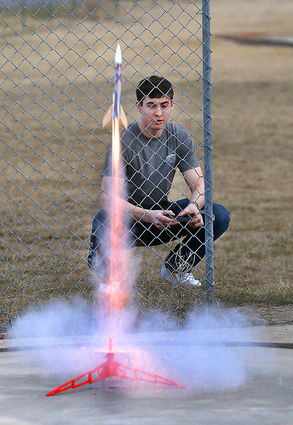
Ed Moreth
UP & AWAY – Andrew Harmon (above) fires a rocket on the second day of launching at Plains High School.
The difficulty of studies at Plains High School isn't rocket science, that is unless a student is a member of Carl Benson's physics class - then it is, and it's not an easy class. But the veteran teacher has a way of helping students understand the intricate problem solving and mathematics equations. They get to build model rockets and fire them off.
Fourteen seniors, seven girls and seven boys, gathered behind the school for two days recently to launch their rockets and record their height and speed, only part of the equations students have to figure out as part of Benson's physics curriculum.
Kelsey Standeford was the first student at the launch pad, counting down before hitting the launch button and sending the "Millennium Falcon," named after a Star Wars spaceship, into the sky, reaching a height of 1,116 feet, the record for most of the first day.
This is the first year that students were able to utilize a mobile altimeter to measure the rocket's assent, said Benson, a teacher for 35 years. The inch-long instrument was clipped onto the rocket fuselage and read after the rocket landed. In the past, they used an impulse equation to determine velocity and the velocity to get the distance, according to Benson. "We only dealt with distance during thrust phase due to the loss of distance because of air resistance as it was decelerating," said Benson. The altimeter gave the students a much more accurate reading, though they still had to do the mathematical equation.
However, they ran into a problem when Mason Gannarelli's rocket landed on the roof of a Clark Fork Valley Hospital building. It didn't halt the launching, but the four remaining launchings of the day went without the instrument. The first day's launching finished when Charlie Rehbein's rocket landed across the highway near the railroad tracks, the farthest away landing spot.
When they got the altimeter back, it had Gannarelli's height at 1,146, the highest of the day. The class resumed Wednesday with Andrew Harmon's rocket reaching 1,040 feet, followed by Emma Morgan's going up 1,130 feet. But then the altimeter broke free during the reentry of Conrad Vanderwall's rocket. Kade Pardee found the instrument about 100 yards from the launching pad. It read Vanderwall's rocket height at 1,094, but the altimeter clip was broke. Benson used wire to attach the altimeter for the rest of the flights.
It took students three class periods to build their rocket kits. This was the first year students had the choice of using plastic prefabricated fins or gluing three single balsa fins onto the fuselage. Benson said the big difference was whether or not the balsa fins were solidly attached and straight, which could alter the flight pattern. About half of the class used plastic fins. Students also had the choice between using a small or large engine, but all of them went with the bigger, more powerful C6-5.
Benson looks for a launching day with very little wind to avoid misdirection of the rockets. The launching sometimes draws a crowd of spectators. A rocket one year altered course immediately off the pad and went right for a group of onlookers. Though no one was hit, Benson said it was funny watching the crowd part like the Red Sea. Most of the rockets this year drifted northwest on the first day, but the wind shifted to the east-south-east on the second day, which meant most would land in the school's football or softball field. The class was able to retrieve all the rockets on the second day until it came to Rehbein's second launch, which went into a field of high weeds on private property some 300 yards away, ending the launching.
Rehbein was one of five students that named their rockets, calling his the "Enterprise" after the Star Trek spaceship. Two years ago, Rehbein built a replica Enterprise captain's chair for the school's annual art exhibit. Rehbein was also part of a school team that gained an honorable mention in the ExploraVision national science competition, along with Audrey Brown and Kylee Altmiller. Their entry in the national competition was "Road Angel," a futuristic hospital on wheels.
Zack Karr named his rocket "Series 1 & 2." His rocket went 1,046 feet. Cree Lulack, whose rocket went up without the altimeter, named her rocket "Death Star" of Star Wars. Andrew Harmon called his "Red Rocket."
The rocketry segment is part of studies on momentum, said Benson, who added they also looked at the speeds of marbles, balls, cars, and trains. The teacher said physics calls for a lot of math, algebra, precalculus, and problem-solving lessons. He uses the rockets to teach the concepts of impulse and velocity, along with the relationship between force and momentum and that for every action there is an opposite reaction. The students must keep detailed records of their launch, weigh the rocket engines before and after launching, fill out a worksheet, and take a test. "One thing that I thought was very interesting was how some of the students were bending and altering their fins to see if they could get more distance. That is what educators love to see," he said.
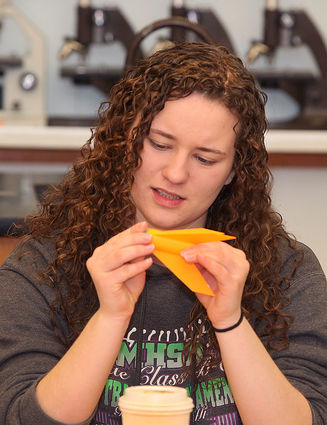
Ed Moreth
NEW PART – Mackenzie Elliott works on her rocket fins. This was the first year that students had the choice between plastic prefabricated fins or individual balsa fins. She ended up with the heaviest rocket at 62.9 grams and calculated her rocket height at 886.7 feet.
Benson has been teaching physics for 30 years and added rocket launching to the class four years later. "It gives them a practical understanding of what we study in the classroom and I think that helps them make the connection," said Benson, who saw substantial grade improvements after adding the rocket building exercise. He uses fun projects for other science subjects, like dropping raw eggs in custom made protective contraptions, crushing cement blocks, and building airplanes to teach the Bernoulli principle.
Mackenzie Elliott had the heaviest rocket at 62.9 grams. Her rocket went up without the altimeter, but she calculated the height at 886.7 feet. The average weight was 58.13 grams. Rehbein had the lightest rocket at 49 grams. Although he lost his rocket twice, he had the highest flight at 1,174 feet. He calculated the speed at 204.08 meters per second. His mathematical equation for his first launch, which was without the altimeter, was 1,138.24 feet. Kade Pardee's rocket went the lowest at 878 feet, followed by Wiley Scribner at 936, who had the slowest rocket speed of 161.3 meters per second. Benson said the average air speed was 174.66 meter per second.
But Benson has other motives behind his scheme. "The good thing about teaching science," said the 59-year-old Benson, "is you can be like a kid and do fun things."
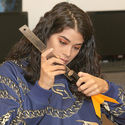
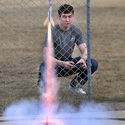
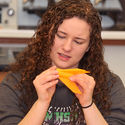






Reader Comments(0)